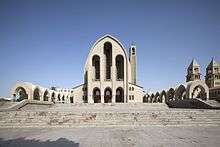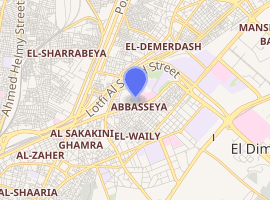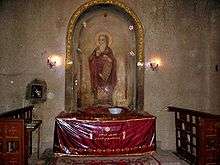Saint Mark's Coptic Orthodox Cathedral
St. Mark's Coptic Orthodox Cathedral is a Coptic church located in the Abbassia District in Cairo, Egypt. The cathedral is the Seat of the Coptic Orthodox Pope. It was built during the time when Pope Cyril VI of Alexandria was Pope of the Coptic Orthodox Church, and was consecrated on June the 3rd 1963.
| Saint Mark's Coptic Orthodox Cathedral | |
|---|---|
 St. Mark's Cathedral in 2010 | |

| |
| Location | Abbassia, Cairo |
| Country | |
| Denomination | Coptic Orthodox Church |
| History | |
| Status | Cathedral |
| Founder(s) | Pope Cyril VI of Alexandria |
| Dedication | Saint Mark |
| Consecrated | 25 June 1968 |
| Architecture | |
| Architect(s) | Awad Kamel |
| Architectural type | Church |
| Style | Coptic |
| Administration | |
| Division | Coptic Orthodox Patriarchate |
| Clergy | |
| Bishop(s) | Pope Tawadros II |
The church is dedicated to St Mark the Evangelist, an apostle of Jesus and founder of the Coptic Church. Relics of his life are kept inside. It was until 2019 (after the inauguration of the new Nativity Cathedral) by far the largest cathedral in Africa[1] and the Middle East.[lower-alpha 1]
History of the land
The cathedral is located in the place of a village called p-Sovt em-p-Hoi (Coptic: ⲡⲥⲟⲃⲧ ⲙ̀ⲡϩⲟⲓ "the wall of the moat") which had been given to the Coptic Orthodox Church in 969 by Gawhar.[2][3][4] This land was a replacement for the land that was taken from the church to be included in building the Palace of Ma'ad al-Muizz Li-Deenillah as part of the planning of the new capital of Egypt, Cairo.[5]
During the twelfth century the area contained ten Coptic churches, but during the rule of Qalawun on 18 February 1280 the churches were destroyed by Muslims who persecuted the Copts. Two churches were subsequently built in the area under the rule of his son.[5]
In 1943 the governorate of Cairo attempted to expropriate the area for public use. This was opposed by the General Congregation Council led by its secretary at the time Habib Elmasry. The campaign proved successful as the Coptic Church maintained control of the land under the condition that a non-profit building be built on it in the following fifteen years. This condition spurred the building of the cathedral.[6]
Office of the Coptic Orthodox Pope

The cathedral is where Pope Tawadros II of Alexandria has his office, thus security is normally high here. However, on 11 December 2016, during the Muslim festival of Mawlid, the chapel near the cathedral was the venue of an Islamic terrorist attack that killed at least 25 people, most of them women and children. This attack is a copy cat of various other earlier attacks against Coptic churches in Egypt.[7][8]
Architecture
The cathedral is considered a unique example of architectural evolution which includes seven churches of which some have a great historic value such as Anba Rouis' Church. The Cathedral represents the rapid development of Coptic architecture,[9][10] the famous Coptic civil engineer Michel Bakhoum contributed in its structural design. It has a capacity for 5,000 worshipers.[11]
Relics of Saint Mark

Before the completion of the Cathedral, the Roman Catholic pontiff of the time, Pope Paul VI, returned part of St. Mark's relics, which were stolen from Egypt in the year 828 to Venice, Italy. These relics were taken to the newly constructed Cathedral, where they were placed in a specially-built shrine brightly decorated with Coptic icons, where they have remained until the present time.
Inauguration ceremony
The inauguration of the new Saint Mark's Coptic Orthodox Cathedral took place on 25 June 1968[12] in a ceremony attended by Egyptian President Gamal Abdel Nasser, Ethiopian Emperor Haile Selassie, among other foreign clergy members from other churches. It is the seat of Tawadros II, Pope and Patriarch of Alexandria and the See of St. Mark.
Burials
Notes
- This claim can still be valid as contrary to popular belief of the largest "cathedral" being the Basilica of Our Lady of Peace of Yamoussoukro in Yamoussoukro, the administrative capital of Côte d'Ivoire (Ivory Coast), which is considered the largest church in the world but not a cathedral. The nearby Cathedral of Saint Augustine is the principal place of worship and seat of the bishop of the Diocese of Yamoussoukro.
See also
| Wikimedia Commons has media related to Saint Mark's Coptic Orthodox Cathedral, Cairo. |
- Botroseya Church bombing / 2016 Cairo Church bombing
- 2017 Palm Sunday church bombings
- List of large Orthodox cathedrals
References
- "Churches in Egypt". Egyptvoyager.com. Retrieved 6 May 2009.
- Gabra, Gawdat; Takla, Hany N. (2017). Christianity and Monasticism in Northern Egypt: Beni Suef, Giza, Cairo, and the Nile Delta. Oxford University Press. ISBN 978-977-416-777-5.
- "Khandaq, Al- :: Claremont Coptic Encyclopedia". ccdl.libraries.claremont.edu. Retrieved 2020-06-14.
- Casanova, Paul. "Les noms coptes du Caire et localités voisines". BIFAO. 1: 139–224.
- "دير الأنبا رويس". Coptichistory.org. Retrieved 28 September 2012.
- St Abraam Archived 2 June 2008 at the Wayback Machine
- "Blast hits near Christian cathedral in Cairo, 25 killed, 49 wounded". RT. 11 December 2016. Retrieved 13 December 2016.
- Hassan, Ahmed Mohammed; Abdelaty, Ali (11 December 2016). "Cairo church bombing kills 25, raises fears among Christians". Retrieved 13 December 2016.
- "Cathedral of Abbasiya - Coptic Cairo". Memphis Tours Egypt.
- Helloegypt Archived 16 August 2007 at the Wayback Machine
- "Old Cairo and Roda Island". Footprinttravelguides.com. Retrieved 28 September 2012.
- "Pope Saint Kyrillos VI (Cyril VI), 116th Pope of Alexandria". Zeitun-eg.org. Retrieved 6 May 2009.